Voluntourism on the rise: a call to reexamine how we help
September 22, 2016
We have all seen this photo on social media: a varying number of white people are surrounded by a varying number of smiling brown or black children. The backdrop is vaguely exotic–perhaps the white people are even sporting ‘native’ clothing. The whole thing is tied together with a nebulous quote related to giving back, gratefulness and how much the person posting the photo has been changed by his or her experience.
While the photo described above has emerged as the stereotypical depiction of the growing global phenomenon of ‘voluntourism,’ in which tourists pay to volunteer abroad or in their home country, many forms of voluntourism are far subtler. On Monday, September 12, 24-year-old writer Pippa Biddle spoke to the Whitman community about the allures and ills of voluntourism at a lecture hosted by the Student Engagement Center. Biddle’s lecture began with a photo of her own, a riff on the one described above, in which a 16-year-old Biddle sits smiling with three young Dominican girls, a moment from a service trip in the Dominican Republic.
Biddle defines voluntourism as “any engagement that involves volunteering in a place that is not your home community and that typically involves touristic experiences.” While voluntourism is typically thought of as occurring outside of one’s own country, Biddle stresses it can take place anywhere there are different levels of development: think rural West Virginia versus New York City.
After participating in a variety of short-term volunteer projects abroad as a teenager, Biddle was troubled by a growing doubt about her long-term impact on the communities in which she volunteered. Biddle critically examines the voluntourism industry in her internationally renowned essay, “The Problem with Little White Girls (and Boys): Why I Stopped Becoming a Voluntourist.” Biddle has since made clear the problem with voluntourism is “not just about little white girls, but…privilege does matter, and it matters a lot.”
The bulk of voluntourists are wealthy white people traveling to less-developed places populated by mostly non-white people. The majority of trips last less than four weeks. According Nancy Gard McGehee, an expert on sustainable tourism at Virginia Tech University, 10 million people engage in voluntourism globally each year and contribute to a growing industry worth around 2 billion dollars.
Part of the problem is where all that money goes. While volunteers pay hundreds or thousands of dollars to go on a trip, most of that money is spent on transportation and food purchased from corporate sources far from the community to which volunteers travel. Precious little of that $2 billion actually finds its way to the local economy. This problem has a name: economic leakage.
Instead of creating opportunities for community development, volunteers typically engage in short term projects–they build libraries, replace roofs and play games with orphans–and neglect to foster community ownership of these projects.
“[Volunteers have] done nothing by being there to make it more likely that [the local population] will be able to afford [the projects] themselves, or that they’ll be able to invest in their own furtherance of their lifestyle and be able to have a better future,” Biddle said.

Biddle explains this trend through the Courtney Martin’s concept of ‘reductive seduction.’
“We really like to look to somewhere else, take what they’re dealing with, reduce it down to as small of a problem as we can and then try to solve it over and over and over again,” Biddle said. By equating saving Africa with building a school or pulling Haiti out of poverty with a couple weeks spent teaching English, voluntourism programs reduce a country’s problems to a small, concrete and achievable-in-two weeks tasks. This provides volunteers a sense of satisfaction and the feeling that they have made a real impact when in fact they may have done more harm than good.
The culture of aid fostered by voluntourism programs “has actually created local cultures that are highly reliant if not entirely reliant in certain places…on aid,” Biddle said. She paraphrased an idea developed in Robert Lupton’s book “Toxic Charity”:
“Give once and you elicit appreciation, give twice and you create anticipation, give three times and you create expectation, give four times and it becomes entitlement, and give five times and you establish a dependency,” Biddle said.
This does not mean that volunteering is useless. But it does call for a critical re-evaluation of how we engage in service.
Biddle explained that because voluntourists are central to voluntourism,“[they] have the ability…to shift where everything is going and to…challenge the problem that we’re dealing with here as far as actually creating systemic long term change in communities that need help but don’t necessarily need our hands, physically.”
It feels good to help other people, but ultimately, Biddle said, “the success of a volunteer experience should not be based on how a volunteer feels after it. It should be based on the actual outcomes to the places where that volunteer is going.”
Pairing Education with Service
Senior Lindsay Ross is an intern for Whitman’s Spring Break Service Trip (SBST) program, which according to the Whitman SBST website, coordinates “week-long volunteer trips that allow Whitman students to focus on a particular social issue outside of the Walla Walla community.”
Last spring Ross led an SBST to the Confederated Tribes of the Umatilla Indian Reservation (CTUIR) about an hour south of Whitman. In order to combat the negative aspects of voluntourism, Ross and her volunteers “try and be really intentional about what we’re doing and why we’re going.” SBST’s are “all focused on working with community partners that are already active in the community” rather than entering a place with assumptions about what is needed.
Ross emphasized the trip’s focus on education, which nearly outweighed the amount of service they did. The trip was almost 100 percent planned by tribal members rather than Whitman students.
Sean Terada 16’, a participant on the CTUIR trip, concurred. Students met with the tribal council who explained how they run things and what their goals are.
“It was kind of a learning experience for all of us. Figuring out what kind of relationship we wanted to have with the reservation as a college because we saw that this was something that we could create a long term relationship with,” Terada said.
Terada, a native Hawaiian, noted the socioeconomic similarities between that of native Hawaiians and Native Americans on the reservation. Both groups exhibit high levels of poverty and low levels of education.
“But I had never really experienced the Native American side of that, so that was a really interesting way to connect those and compare them,” Terada said.
The emphasis on education-based trips echo Biddle’s own pursuit to create more meaningful tourism. Biddle belongs to the board of Onwards, a non-profit that offers trips rooted in education in places like the Dominican Republic and Guatemala. Rather than engaging participants in superficial forms of service, Onwards seeks to educate travelers about local issues so that tourists “walk away more empowered [and] more ready to do meaningful work in the future,” Biddle said.
Onwards fosters local development by providing micro-loans to local businesses in the tourism sector, allowing the community to capture more of the money tourism brings.
“The question isn’t ‘how do we keep white people out?’ It’s ‘how do we create a strong community that can engage with this in a way that makes us stronger as a community?’” Biddle said. By keeping tourism dollars in the community, the local population is able to achieve progress through their own work.
The Ambiguity of Aid
First years Cameron Conner and Grant Gallaher spent much of the past year working in Nepal to implement disaster relief after the April 2015 earthquake that killed thousands of people and altered the lives of many more.
The two worked through Conscious Connections, a nonprofit Cameron and his parents founded in 2014 as an extension of his parents’ fair trade business, Ganesh Himal Trading. By tapping into the fair trade company’s base of reliable, trusting relationships formed over thirty years of mutually beneficial business, Conner and Gallaher arranged for aid to be distributed by local people to earthquake victims weeks before any international organizations in the area. The pair spent two weeks performing an evaluation of this initial round of aid.
”Our evaluation found that because of our small scale and our really reliable connections we were able to have some of the most necessary aid,” Conner said. “We knew exactly what was needed and tried not to give superfluous items to people.”
Conner and Gallaher’s success with administering disaster relief highlights the importance of what many voluntourism programs lack: a true understanding of the needs of an area and the relationships with the local population to effectively implement aid.
Conscious Connections performs a variety of aid-based functions for the district of Dhading where it is located, including educational scholarships and a health clinic. Despite the success with administering relief after the earthquake, Conner explained, “No matter how good a relationship you have within a community,” it is difficult to build community ownership when the relationship is one of givers and receivers.
That is why Conner believes “everything aid related is fundamentally flawed.”
“There’s still a paternal-ish relationship. As much as you respect the other person, you are in a position of power.”
That is why Conner sees businesses like his parents’ as “one of the best ways to kind of circumvent [unequal power relations] because trade naturally builds mutual ownership.”
Gallaher urges people to continue to seek volunteer opportunities despite the hazards of voluntourism.
“I don’t want that to ever stop people from looking for ways to make a difference in those sorts of places. I just think people need to think more critically about what they’re doing.”
While Gallaher would like to go back to Nepal some day, he is not sure if he would return as a volunteer or a tourist. After the earthquake, Nepal’s tourism industry decreased by up to 80 percent in some areas, so “in a lot of ways what Nepal needs right now is just tourists,” Gallaher said.
Conner urges students to “look within your own community” to find volunteer opportunities. “It just so happens that I have a wonderful community in Nepal.”






